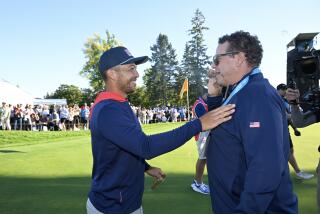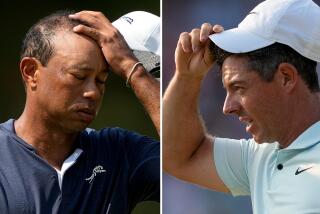Ryder Cup Matches Now Less Friendly : But It’s Still a Revival of “The War by the Shore,” in 1991 at Kiawah Island, S.C., Where U.S. Snapped 6-Year Skid
- Share via
SUTTON COLDFIELD, England — The Ryder Cup matches, conceived as an international exercise in goodwill, have become less friendly and more frenzied.
The biennial matches, begun in 1927 by British seed merchant Samuel Ryder as get-togethers between pro golfers of the United States and Britain, will be played for the 30th time next weekend at the Belfry in the English Midlands.
It’s a revival of “The War by the Shore,” in 1991 at Kiawah Island, S.C., where the United States broke Europe’s 6-year hold on the Cup in the gasping pressure of one of the most dramatic golf tournaments.
The three-day matches now represent golf’s greatest international show. U.S. captain Tom Watson says they are even more than that.
“The Ryder Cup is unique in all of sports,” Watson said.
He based the statement on the singular situation of 24 of the game’s highest-paid performers playing for nothing but pride. No cash is involved.
This year’s matches, however, feature politics and partisanship, a couple of wild-card Spaniards, an inexplicable quirk of history, and a dash of gamesmanship.
Watson, most of his 12 players, and the official PGA party will depart for England on Monday immediately after meeting with President Clinton at the White House.
The scheduling of that traditional send-off produced a minor political flap when derogatory remarks about Clinton were made by some members of the mostly Republican team.
Appropriate apologies were made and “that’s now behind us,” Watson said.
Ahead of them is the chartered Concorde flight. Seve Ballesteros, a member of the European team, says that flight will be nothing but an expensive courier service.
“All they are doing by coming here is bringing us the Cup back. We will win the Cup. No question,” Ballesteros said after a runner-up finish in the European Masters.
The best performance in more than a year by the Spanish ace followed his selection to the European team as one of three wild-card choices by captain Bernard Gallacher of England.
Gallacher also picked Jose Maria Olazabal of Spain and Joakim Haeggman, the first Swede to play for Europe.
Ballesteros, twice the winner of the Masters and a three-time British Open winner, was the critical choice, however. And the apparent end of his lengthy slump could not come at a better time for Europe, said Watson, the U.S. captain.
“Seve gives the European team a big lift, psychologically and physically,” Watson said. “He will be a point of strength for Europe.”
Olazabal almost certainly will be his partner in the foursomes and fourball matches that have been the decisive factors in the last decade, a period in which Europe first became competitive and then dominated the matches that once were ruled by the Americans.
At Palm Beach Gardens, Fla., in 1983, the United States won 14 1/2-13 1/2. In ’85 at the Belfry, Europe broke a 28-year non-winning string 16 1/2-11 1/2, then followed in ’87 at Muirfield Village in Ohio with a 15-13 triumph.
The Europeans retained the cup on a 14-14 tie at the Belfry in ‘89, but the United States regained the Cup 14 1/2-13 1/2 in ’91 when Bernhard Langer of Germany missed a 5-foot putt on the final hole of the final match.
Over that period, the Europeans led in total score 72 1/2-67 1/2.
In every case, the strength of the European scoring came in the four afternoon four-ball matches on opening day--matches in which scoring is based on the better ball of each two-man team.
The Europeans have won 17 of a possible 20 points in those matches, including 4-0 sweeps in ‘85, ’87 and ’89. Since Olazabal joined Ballesteros as a partner in ‘87, the Spanish pair are 3-0 in first-day four-ball matches and 5 1/2- 1/2 overall in four-ball play.
“Obviously, they play very well together,” Watson said. He could offer no explanation for the European’s overall domination of the better-ball matches.
“You’d think we’d play better there than in the foursomes,” Watson said, referring to the format under which each member of a two-man team plays alternate shots on the same ball.
Four matches under each format are scheduled both Friday and Saturday, with Sunday’s play given over to 12 singles matches. Each match is worth one point. A match tied at the end of 18 holes is halved.
Also awaiting the American team are such European veterans as Langer, the current Masters champion, Ian Woosnam of Wales and Nick Faldo of England, ranked No. 1 in the world. All were members of European teams unbeaten at the Belfry.
Other European players are Constantino Rocca, the first Italian member of the team; Peter Baker, Mark James and Barry Lane of England; and Sam Torrance and Colin Montgomerie of Scotland.
All can expect highly partisan support from crowds that, in the two previous visits to the Belfry, more closely resembled British soccer crowds than the traditionally subdued English golf gallery.
“There’s partisanship. And that’s fine. There should be partisanship,” Watson said. “The hometown crowd should be rooting for their guys.”
But it’s become much more rowdy in recent years, with the wives of American players being booed and jeered on their last visit.
With that in mind, Watson said he wanted players who could rise to the occasion, who could use adversity to spur them on.
As a result, he exercised his two wild-card picks on veterans Ray Floyd and Lanny Wadkins, each of whom will be making his eighth Ryder Cup appearance.
The other American team members are PGA champion Paul Azinger, Fred Couples, Tom Kite, U.S. Open title-holder Lee Janzen, Corey Pavin, Payne Stewart, John Cook, Davis Love III, Chip Beck and Jim Gallagher.
“It’s a strong team,” Watson said, “stronger than the Europeans.
“But the home course advantage falls to them, and that can make a difference. It should be a helluva series of matches.”
More to Read
Go beyond the scoreboard
Get the latest on L.A.'s teams in the daily Sports Report newsletter.
You may occasionally receive promotional content from the Los Angeles Times.










